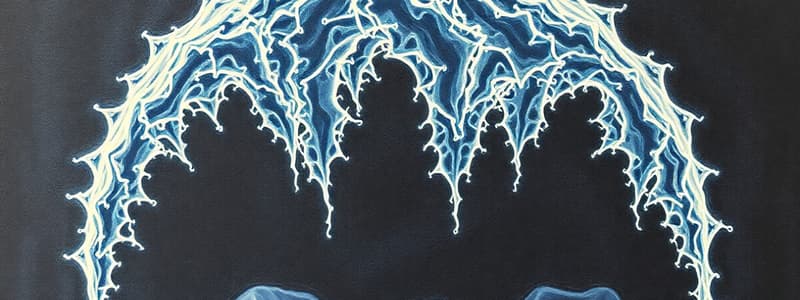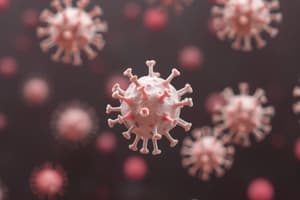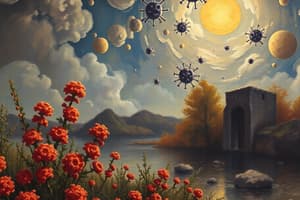Podcast
Questions and Answers
Which characteristic distinguishes prokaryotic cells from eukaryotic cells?
Which characteristic distinguishes prokaryotic cells from eukaryotic cells?
- Eukaryotic cells reproduce through binary fission.
- Prokaryotic cells lack membrane-bound organelles. (correct)
- Eukaryotic cells lack membrane-bound organelles.
- Prokaryotic cells have a nucleus.
A scientist is investigating a new disease outbreak caused by a previously unknown microbe. Which branch of microbiology would be MOST relevant to identifying and characterizing this microbe?
A scientist is investigating a new disease outbreak caused by a previously unknown microbe. Which branch of microbiology would be MOST relevant to identifying and characterizing this microbe?
- Immunology
- Virology
- Bacteriology (correct)
- Mycology
Which of the following microbial processes is NOT primarily associated with nutrient cycling and decomposition in ecosystems?
Which of the following microbial processes is NOT primarily associated with nutrient cycling and decomposition in ecosystems?
- Fermentation
- Pathogenesis (correct)
- Aerobic Respiration
- Photosynthesis
A researcher discovers a new species of bacteria that thrives in extremely acidic conditions. Which factor would be MOST critical to study in order to understand its survival mechanisms?
A researcher discovers a new species of bacteria that thrives in extremely acidic conditions. Which factor would be MOST critical to study in order to understand its survival mechanisms?
Why is the study of antimicrobial resistance considered a critical area within microbiology?
Why is the study of antimicrobial resistance considered a critical area within microbiology?
A wastewater treatment plant uses microorganisms to break down pollutants. This application of microbiology is BEST described as:
A wastewater treatment plant uses microorganisms to break down pollutants. This application of microbiology is BEST described as:
How do the processes of transduction, transformation, and conjugation contribute to microbial adaptation?
How do the processes of transduction, transformation, and conjugation contribute to microbial adaptation?
Which of the following cellular structures is MOST directly responsible for providing bacteria with their specific shape and protection from osmotic stress?
Which of the following cellular structures is MOST directly responsible for providing bacteria with their specific shape and protection from osmotic stress?
A scientist discovers a new bacterium. Initial analysis reveals the presence of a thin peptidoglycan layer and an outer membrane. This bacterium is MOST likely:
A scientist discovers a new bacterium. Initial analysis reveals the presence of a thin peptidoglycan layer and an outer membrane. This bacterium is MOST likely:
Which of the following cellular structures is directly involved in the exchange of genetic material between bacterial cells?
Which of the following cellular structures is directly involved in the exchange of genetic material between bacterial cells?
During which phase of the bacterial growth curve does the rate of cell division equal the rate of cell death, resulting in a stable population size?
During which phase of the bacterial growth curve does the rate of cell division equal the rate of cell death, resulting in a stable population size?
A bacterium is cultured in an anaerobic environment. Which metabolic process is it MOST likely using to generate energy?
A bacterium is cultured in an anaerobic environment. Which metabolic process is it MOST likely using to generate energy?
Which of the following processes involves the transfer of genetic material from one bacterium to another via a virus?
Which of the following processes involves the transfer of genetic material from one bacterium to another via a virus?
A bacterium produces a toxin that causes damage to the host's intestinal lining. This toxin is BEST classified as a:
A bacterium produces a toxin that causes damage to the host's intestinal lining. This toxin is BEST classified as a:
Which control method is MOST effective at eliminating all microorganisms, including bacterial spores?
Which control method is MOST effective at eliminating all microorganisms, including bacterial spores?
A bacterium develops resistance to an antibiotic by modifying the antibiotic's target site within the cell. This is an example of which resistance mechanism?
A bacterium develops resistance to an antibiotic by modifying the antibiotic's target site within the cell. This is an example of which resistance mechanism?
Which of the following biogeochemical cycles relies MOST heavily on the activity of microorganisms to convert atmospheric nitrogen into usable forms for plants?
Which of the following biogeochemical cycles relies MOST heavily on the activity of microorganisms to convert atmospheric nitrogen into usable forms for plants?
The human gut microbiome is an example of:
The human gut microbiome is an example of:
Flashcards
Microbiology
Microbiology
The study of microorganisms, including bacteria, archaea, fungi, protozoa, and viruses.
Bacteriology
Bacteriology
The study of bacteria, including their identification, classification, structure, function, and interactions.
Virology
Virology
The study of viruses, their structure, replication, genetics, and effects on hosts.
Mycology
Mycology
Signup and view all the flashcards
Parasitology
Parasitology
Signup and view all the flashcards
Cell Structure
Cell Structure
Signup and view all the flashcards
Control of Microbes
Control of Microbes
Signup and view all the flashcards
Bacterial Cell Wall
Bacterial Cell Wall
Signup and view all the flashcards
Capsule
Capsule
Signup and view all the flashcards
Binary Fission
Binary Fission
Signup and view all the flashcards
Growth Curve
Growth Curve
Signup and view all the flashcards
Sterilization
Sterilization
Signup and view all the flashcards
Disinfection
Disinfection
Signup and view all the flashcards
Virulence Factors
Virulence Factors
Signup and view all the flashcards
Toxins
Toxins
Signup and view all the flashcards
Adhesins
Adhesins
Signup and view all the flashcards
Transduction
Transduction
Signup and view all the flashcards
Microbiome
Microbiome
Signup and view all the flashcards
Study Notes
The provided text is identical to your existing notes, so there are no updates or changes to make.
Studying That Suits You
Use AI to generate personalized quizzes and flashcards to suit your learning preferences.




